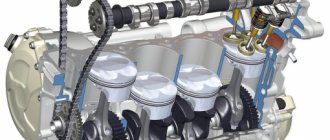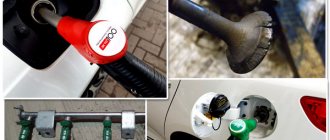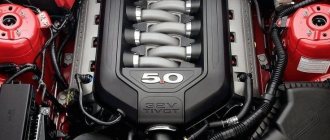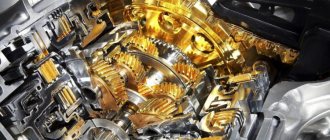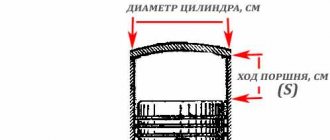The thermal efficiency of the engine depends on the amount of compression. But as the degree increases, the risk of detonation also increases, so when boosting and overhauling, time should be spent on calculations. Let's look at how to increase the compression ratio of an engine, the relationship between compression and ratio, and what makes a Miller-Atkinson cycle engine so special.
How are compression ratio and engine compression related?
The compression ratio in the engine cylinders is an absolute value and is calculated mathematically. In practice, this ratio reflects the compression ratio of the fuel mixture entering the cylinder during the intake stroke. The concept of compression refers to the peak pressure in the combustion chamber at the end of the compression stroke and can be measured practically. Although compression is a derivative of the compression ratio, it depends on many factors:
- tightness of the cylinder-piston group (CPG) and valve mechanism;
- starter power, battery condition and contact quality, which affects the number of starter revolutions.
Turbocharged engines
On turbo engines, the calculation of the compression ratio is different. This is due to the presence of air pressure. Therefore, in this case, the value obtained during the calculations is multiplied by the turbocharger indicator.
In addition, when calculating the compression ratio of turbocharged engines, not only the boost pressure is taken into account, but also the effective compression indicator, climate changes and much more. In this case, the process becomes significantly more complicated compared to measurements on an atmospheric engine.
Boosting the engine by increasing the compression ratio
The higher the degree, the hotter the air at the end of the compression stroke and the higher the engine efficiency. But an increase in one parameter does not guarantee a linear increase in the second. The greatest increase in power is felt when the degree is increased to 10-11 units.
For example, by increasing the compression ratio of a standard VAZ engine from 9.8 to 11, we theoretically get an increase in thermal efficiency by 4%. The bench test will show a much more modest value - 2.5%. By increasing the compression ratio of the same engine by another unit, we get an actual increase of 4.5%. The torque characteristic will increase mainly at low and medium speeds. Further increasing the compression ratio without switching to high-octane sports fuel will not produce results at all.
The reason for this phenomenon is detonation, which occurs when the peak pressure in the combustion chamber is too high. Upon contact with heated air, in this case the mixture spontaneously ignites even before the spark is applied. In this case, the flame front propagates at a speed of more than 2000 m/s, whereas the value for normal combustion does not exceed 250-300 m/s.
A shock wave of such force exerts destructive pressure on the cylinders, combustion chamber walls, and pistons. The temperature of the exhaust gases also increases significantly, which leads to burning out of the piston crown and valves.
Therefore, compression tuning should be carried out after an accurate mathematical calculation and with an eye to the octane number of gasoline.
Why is it necessary to change the compression ratio?
The need to change this parameter of the internal combustion engine occurs quite rarely. We can list just a few reasons to do this.
- Boosting the engine.
- The desire to adapt the engine to run on gasoline with a different octane number. There was a time when gas equipment for cars was not available for sale. There was no gas at gas stations either. Therefore, Soviet car owners often modified engines to run on cheaper low-octane gasoline.
- Unsuccessful engine repair, to eliminate the consequences of which requires adjustment of the compression ratio. For example, milling a block head after too much thermal deformation. When it is possible to level the surface mating to the cylinder block at the cost of removing an excessively thick layer of metal. This increases the value of the coefficient so much that operation on gasoline, for which the engine was designed, becomes impossible.
How does a variable compression ratio engine work?
Until recently, the exponent was laid down by engineers at the development stage and was fixed regardless of the engine operating mode. The normal value for modern gasoline engines varies from 8 to 14 units; the traditionally high compression ratio for diesel engines is 18-23.
Tightening environmental standards is forcing engineering geniuses to look for new ways to increase thermal efficiency. One such solution is an engine with a variable compression ratio. Several options for dynamic degree changes have been developed:
- additional section in the cylinder head cavity. Opening the section allows you to increase the volume of the combustion chamber, thereby reducing the degree. The system did not become widespread due to the excessive complexity of the cylinder head design;
- pistons with variable height. The design turned out to be too bulky, problems arose with misalignment of the pistons and sealing of the CPG;
- crankshaft lift height adjustment. The compression ratio is changed using special eccentric couplings that regulate the height of the crankshaft support bearings. The technology was tested by VAG for a long time, but never entered the series;
- cylinder head lift height adjustment. A special mechanism with an electric drive and a hinged connection of parts of the engine block made it possible to adjust the degree from 8 to 14 units. The technology was developed by SAAB engineers, but due to the unreliability of the rubber casing sealing the moving parts of the block and the excessive complexity of the design, it also did not go into production;
- connecting rod with variable length. The height of the connecting rod was adjusted by a special rack and pinion mechanism using oil pressure. As in previous cases, the development of French engineers was not introduced into mass production;
- traverse mechanism for connecting the connecting rod with the crankshaft. By changing the angle of rotation of the traverse, the piston stroke decreases or increases. The development of Infiniti engineers is used on the two-liter VC-T engine, which is now installed on the QX50 crossover. The engine develops a maximum power of 268 hp. and peak torque of 380 Nm.
What does this indicator affect?
This indicator directly affects the amount of work that the car engine will have to produce. The higher the degree, the more energy will be released when the fuel mixture is burned. Ultimately, such a unit will produce more power, measured in horsepower. For this reason, most automakers at the end of the last century tried to increase the performance of their engines by increasing the coolant. At the same time, it did not occur to them to expand the volume of the combustion chambers or cylinders. It is worth noting that boosting units in this way actually leads to a serious increase in horsepower. At the same time, the engine does not consume more fuel. Thus, the engines become not only powerful, but also economical.
However, such a boost has limitations. First of all, you need to remember that if you compress the mixture to a certain amount, it can simply detonate. That is, it will spontaneously explode. Note that such a process is only possible in gasoline internal combustion engines. In diesel engines, explosions do not occur due to the fact that they have, on average, a higher compression ratio. In order to increase the value of detonation pressure, it is necessary to increase the octane number of the fuel, for example, fill the car with AI-98 gasoline, which costs several times more. At the same time, a number of car enthusiasts are starting to use various chemical additives. The latter not only do not have a long-term effect, but also worsen the environmental parameters of the engine. Separately, it is worth noting that filling with fuel with a higher octane number is also not the most effective method of increasing detonation, since this characteristic does not in any way affect the calorific value of the fuel.
Miller-Atkinson cycle
The Miller-Atkinson cycle gained great popularity thanks to Mazda advertising brochures. Marketers proudly declare that engineers managed to increase the compression ratio of the Skyactive model engines to 14 units. In fact, we are talking about the geometric compression ratio, not the actual one.
The trick is that during the rise of the piston on the compression stroke, the exhaust valves are still open for a long time, which is why part of the fresh air charge is pushed into the exhaust tract. Therefore, the actual degree is close to the standard 12 units for gasoline engines. An increase in thermal efficiency is achieved through more efficient use of the energy of expanding gases during the power stroke. Due to the longer stroke (increased crank diameter), the gases press on the piston longer. Therefore, when the same proportion of fuel is burned, compared to the conventional Otto cycle, more torque is transmitted to the crankshaft. The technology makes it possible to significantly reduce fuel consumption and the amount of harmful emissions in low and medium load modes.
What should the compression be?
To identify the point of maximum wear of engine parts, you need to know the permissible pressure values. It is related to the degree of compression in direct proportion - the more, the higher the pressure.
Today you can find 3 types of engines in operation with different characteristics:
- Old engines with a low compression ratio - up to 8.5.
- Modern gasoline engines in which the air-fuel mixture is reduced in volume by up to 9-11 times.
- Diesel engines capable of compressing the fuel mixture from 16 to 24 times.
The combustion chamber of an engine running on diesel fuel is characterized by a small volume. Therefore, the motor does not require an electric spark, just strong compression.
The amount of compression is influenced by various factors:
- tightness of valve seating;
- cracks in valve seats;
- presence of lubricant in the cylinders;
- ring wear;
- wear of parts of the cylinder-piston group.
Norm and minimum
Through testing, data on the optimal pressure in the cylinders for different types of engines was obtained. When the engine has reached operating temperature and the battery is fully charged, the compression should be:
- On older engines equipped with carburetors, the lowest value is 1 megapascal. In old units - 10 bar. If the engine is new, the pressure can reach 13 bar.
- The optimal pressure in a gasoline engine is 1.5 megapascals. The minimum level is 1.1 MPa.
- For a diesel engine, the normal value is 2.4-3 MPa.
It is important to know! Analysis of parameter measurements allows us to establish a pattern that a compression ratio with a coefficient of 1.5 gives the optimal pressure in the cylinders.
If we more accurately determine the indicated coefficient, then for 4-stroke gasoline engines it is in the range of 1.2-1.3, for diesel engines - 1.7-2.
Signs of poor compression
Identification of the lower compression limit indicates increased engine wear. Friction occurs between the piston rings and the cylinder, which increases the gap between the parts. For this reason, compression is reduced.
The following signs can indicate that the compression is insufficient:
- There is a lot of smoke coming out of the breather. This is a valve that serves to remove crankcase gases from injection and carburetor engines.
- Reduced power of the power unit, especially noticeable on small engines.
- A lot of smoke comes out of the exhaust pipe as the engine oil burns in large quantities.
- High oil consumption due to wear of oil scraper rings and caps.
If at least one of these signs is noticed, then there is a reason to conduct a full engine diagnostics.
This will allow timely measures to be taken to restore its functionality. If we consider the reasons for the decrease in compression, we can highlight the main ones:
- Operating a car with a cold engine, thermostat failure.
- Overheating of the power unit.
- Use of low quality lubricant.
- Maintenance and oil changes are not carried out in a timely manner.
- The service life of the engine has expired.
If the head gasket is burned out or the valves are damaged, then changing the lubricant will not help. In these cases, engine repair will be required with replacement of piston group parts and other elements.
Permissible compression difference in cylinders
If the measured compression differs between cylinders, this complicates matters. The engine will have to be disassembled and overhauled. Not only will it be necessary to replace rings, valves and sealing caps.
Compression less than the minimum value in one cylinder means that there are defects in the piston or cylinder. In this case, all elements of the cylinder-piston group are usually changed, otherwise the difference in compression will remain and the problem will not go away.
The normal value is considered to be a pressure of 10-12 bar, depending on the car model and engine. But the permissible difference in compression in different cylinders has also been established. For example, in cylinders 2 and 3 this value may be 0.5 bar lower, which is quite acceptable. It depends on the load on the pistons - where there is more, there is more wear.
Mathematical calculation
The compression ratio of an internal combustion engine is equal to the volume of the combustion chamber divided by the working volume of the cylinder and is calculated by the formula (V + C)/C = CR, where
- V is the volume of the cylinder when the piston is at bottom dead center (BDC). To calculate, it is necessary to divide the sum of the volumes of all cylinders (indicated in the technical characteristics of the internal combustion engine) by the number of boilers;
- C is the volume of the combustion chamber when the piston is at top dead center (TDC). Includes the volume of the cylinder head cavity, cylinder head gasket and cylinder recesses. If the piston has a convexity, its volume is subtracted from the total volume of the combustion chamber.
Calculating the compression ratio mathematically is quite difficult due to the complex geometric shape of the combustion chamber. Therefore, in practice, 2 main calculation methods are used.
Video: How to measure the compression ratio correctly.
Counting example
This is what the generally accepted calculation formula for an automobile internal combustion engine looks like: “SSD = (RO+OKS)/OKS.” The compression ratio here is o, the working volume of the cylinder is “RO”, and the volume of the combustion chamber is “OKS”.
To calculate “PO,” you must first decompose the single engine volume or displacement into the number of cylinders used. For example, the displacement of the “four” engine is 1997 cm3. To determine the capacity of one cylinder, you need to divide 1997 by 4. You get about 499 cm3.
To calculate the “OCS” parameter, specialists use a tube or pipette calibrated in cm3. The chamber refers to the place where the fuel ignites directly. The chamber is primed and then the volume is measured using a liquid burette. If you don't have a graduated tube, you can pump out the liquid with a syringe and then measure it in a measuring cup or on a scale. In this case, it is advisable to use clean water for calculations rather than gasoline or diesel fuel, since its specific gravity is more related to the volume in cm3.
Attention! To accurately measure “OKS”, the thickness of the cylinder head gasket is additionally added, the shape of the piston crown and other features are taken into account. Therefore, it is recommended to entrust the calculation of this value to specialists.
Practical calculation by pouring method
The essence of the measurement is to alternately fill with liquid the area above the piston, when it is at top dead center, and the walls of the cylinder head combustion chamber. To measure, we need a piece of plexiglass in which holes will be cut for screwing in the cylinder head bolts and a hole for filling the liquid. Between the plexiglass and the block it is necessary to install an already used (crimped) gasket. To increase hydraulic tightness, the cylinder walls must be lubricated with thick grease (lithium or ordinary grease).
After tightening the plexiglass with bolts, fill the resulting volume with liquid. The volume of water placed will correspond to the volume of the space above the piston. A similar test is carried out with the block head. In this case, the valves must be ground in, and grease must be applied between the seats and plates. The sum of the volume of liquids filled will be the volume of the combustion chamber.
To calculate the compression ratio using an online calculator, you will also need to measure the piston stroke and cylinder diameter. All these values will help to calculate the engine volume, which changes with each milling of the planes of the cylinder head, cylinder head, installation of pistons of a different geometric shape, boring of the cylinders, or installation of other connecting rods or crankshaft.
Engine depowering: why it is needed and how to do it
Sometimes it is necessary to reduce the compression ratio. In this case, an additional metal cylinder head gasket is installed. You can use two gaskets instead of one, thereby thickening the gap - the volume of the chamber increases due to the height of the block head. A more complex method involves shortening the piston - removing the top layer on a lathe.
Engine depowering is usually a forced procedure. This is done, among other things, to reduce tax payments or to increase the resource of the unit. As you know, engines with a low compression ratio last longer and are less susceptible to wear. However, any such process is complicated by law to prevent unscrupulous owners from artificially lowering technical data.
As for reducing the compression ratio on turbocharged engines, it will require upgrading the electrical system with sensors, the entire piston group and injectors if it is a diesel unit.
In some cases, a swap is preferred to depowering, when a less powerful contract motor is installed instead of a standard one.
Is it possible to calculate the degree by measuring the compression?
Compression directly depends not only on the concept of engine compression ratio, but also on the nature of the compressed gas and the conditions in the combustion chamber. In practice, the dependence of these parameters results in the formula P = Po*Ɛƴ, where
- Po is the initial pressure in the cylinder, taken as 1;
- Ƴ – adiabatic indicator for air. In an internal combustion engine, during compression, part of the heat is transferred to the walls of the cylinder, combustion chamber; Some of the gas leaks through leaks, and the air is mixed with fuel particles, so the process is considered non-diabetic. In this case, the polytropic index is not equal to the reference 1.4, but close to the actual 1.2.
All this means that by measuring compression, we can calculate the compression ratio of the engine. For example, with a compression of 15.8, the compression ratio will be close to 10 units. To reduce the error, you must follow all the rules for measuring compression:
- The spark plugs must be unscrewed.
- The throttle is 100% open.
- Fuel supply is turned off.
- The battery must be fully charged. In this case, the capacity should be enough to measure compression in all boilers.
- The starter must be in good working order, and there should be no significant voltage drop on its power wires due to oxides.
Seal
The main reasons to check the engine:
- sluggish acceleration;
- low oil pressure;
- high oil consumption;
- problematic startup;
- low compression;
- blue exhaust gases;
- high fuel consumption;
- rough idle;
- severe detonation;
- carbon deposits on spark plugs / frequent replacement of spark plugs;
- knocking/engine overheating;
- wear of gaskets;
- pulsation in the gas exhaust hose from the crankcase.
Initially, engines were made from such well-known and common materials as cast iron, steel, bronze, aluminum and copper. But in recent years, automakers have been striving to achieve more power and less weight for their engines, and this has prompted them to use new materials - ceramic-metal composites, silicon-nickel coatings, polymer carbons, titanium, and various alloys.
The heaviest part of the engine is the cylinder block, which historically has always been made of cast iron. The main task is to make cast iron alloys with the best qualities, without sacrificing its strength, so that you don’t have to make cylinder liners from cast iron (this is sometimes done on trucks, where such a structure pays off financially).
Methods for restoring compression
There are several ways to increase the pressure in the engine if the rings are stuck:
- Pour 100 ml of engine oil into each cylinder. It is necessary to give time for the rings to “throw away”. Periodically you need to turn the crankshaft.
- The second method is more effective. A mixture of kerosene, acetone and motor oil is prepared in a ratio of 1:1:1. 50 g is poured into each cylinder, the spark plugs are put in place, and the engine is left alone for 10 hours. Next, the spark plugs are removed, and the engine is cranked by the starter several revolutions. After installing the spark plugs, you need to start the engine and warm it up to 40 degrees. Then the oil is drained and the system is washed with a special product. All that remains is to add fresh oil and replace the filter.
In addition, special chemicals for normalizing compression can be found on sale. Such products contain additives that are poured into the engine. But their effectiveness is questionable, and responsibility for use lies with the car owner.
Some interesting facts
Methanol race car engines have a compression ratio of over 15:1. By comparison, a standard carbureted engine consuming unleaded gasoline has a maximum compression of 1.1:1.
Of the production models of gasoline engines with 14:1 compression, there are models on the market from Mazda (Skyactiv-G series), installed, for example, on the CX-5. But their actual coolant is within 12, since these engines use the so-called “Atkinson cycle”, when the mixture is compressed 12 times after the valves are closed late. The efficiency of such engines is measured not by compression, but by expansion ratio.
In the middle of the 20th century, in the global engine industry, especially in the USA, there was a tendency to increase the compression ratio. Thus, by the 70s, the bulk of American automobile industry samples had a coolant ratio from 11 to 13:1. But the normal operation of such internal combustion engines required the use of high-octane gasoline, which at that time could only be produced by the ethylation process - by adding tetraethyl lead, a highly toxic component. When new environmental standards appeared in the 1970s, leaded lead was banned, and this led to the opposite trend - a decrease in coolant in production engines.
Modern engines have an automatic ignition angle control system, which allows the internal combustion engine to operate on “non-native” fuel - for example, 92 instead of 95, and vice versa. The OZ control system helps to avoid detonation and other unpleasant phenomena. If it is not there, then, for example, if you fill an engine with high-octane gasoline that is not designed for such fuel, you can lose power and even fill the spark plugs, since the ignition will be late. The situation can be corrected by manually setting the OZ according to the instructions for a specific car model.
